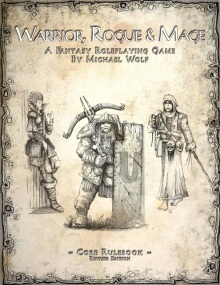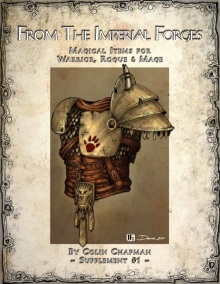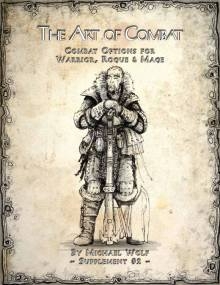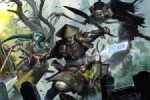
Product Name: Warrior, Rogue & Mage
Publisher: Stargazer Games
Author: Michael Wolf
System:
Setting:
Theme: Fantasy
Type: Core
Link: http://www.stargazergames.eu/
I recently posted about Stargazer Games releasing a new supplement called Discovered Lore for their Warrior, Rogue & Mage role-playing game. When I navigated to DriveThruRPG, I noticed that not only the new supplement but the entire range of published products are completely free. I decided to download the entire suite and give it an in-depth review.
CORE RULEBOOK
Don’t be fooled by the title, Warrior, Rogue & Mage do not refer to the characters that you are able to create within this role-playing game. They are in fact part of the mechanics themselves. Warrior, Rogue & Mage (WR&M) is a rules-light roll-over fantasy role-playing game using only d6s and placed in the fictional realm of the fallen Imperium of Vaneria. Even though the game has this setting in mind, it can easily be adapted to any fantasy setting that a GM can possibly create. It is generally open-ended and keeps from tying the hands of the GM or the players.
The core rulebook starts with an explanation of character creation. WR&M takes the ever-popular concept of attributes and condenses it into 3 simple player stats plus 4 calculated stats. Warrior, Rogue, and Mage refer to the 3 simple stats that are used to define a player character (PC). These three stats are used to encompass a number of stats and skills that are prevalent in other game systems. Warrior refers to a PCs strength, toughness, and risk-taking. Rogue refers to a PCs agility, cunning, and speed. Mage refers to a PCs intelligence, willpower, and discipline. Because of the flexibility with these simple attributes, players are able to make any type of PC imaginable without being confined to often-typical requirements.
These stats are then augmented by choosing skills for the PC from a list of options. It should be noted that each skill is tied to a basic attribute and your PC must have at least a 1 in that attribute to choose that skill. These skills are not meant to define what a PC can or cannot do, but rather how well they do a particular action. This is apparent by the fact that skills add bonuses to an action roll rather than dictating whether that roll can be made or not. Basically, all PCs are capable of performing all actions, but how good they are depend on their “training” (skills chosen). This is a great mechanic that gives you the feel that your PC is a heroic figure and can perform tasks that a normal person would not be able to perform.
To further flesh out your PC, you then choose a talent from the given list to enhance your PCs abilities or to give them the ability to perform fantastic feats. The list of talents is somewhat limited, but give enough options to make the PCs unique from each other and their possible counter-parts.
Once the PC have gone through these steps, its now time to calculate the remaining 4 stats that are used throughout the game. Like most games, WR&M uses Hit Points to determine how much damage your PC can take. This is fairly standard and coincides with the damage that can possibly be dealt from the given range of weapons. The next stat is Fate which is used as a PC saving tool or a way to alter the story in favor of the PCs. The 3rd stat to calculate is Mana, a stat that is used for performing magical acts. This is very similar to the Savage Worlds use of Power Points as a PC taps into their Mana pool when using magic. This gives a great feel that your magic-bearing PC is not able to use their magical powers all day long at the highest level, but rather they are only able to perform so much magic before they must rest and regain their “strength”. The last stat calculated is defense. The best part of this stat is that your PC only has one defense stat and all attacks take this into consideration. This helps to make game-play much more simple and quick.
MECHANICS
Now that your PCs are created, its time to get into the mechanics of the game. WR&M only utilizes six-sided dice for all actions and damage. Again, this adds to the simply and quick game-play. The GM creates a difficulty level (DL) for which the player must meet or exceed for success. From here you add the appropriate stat (Warrior, Rogue, or Mage) along with any bonuses conveyed from a skill that is associated with the action being performed. The usage of stats make it simple for this mechanic as your stat is the bonus applied, as opposed to having to calculate the bonus from a table or cross-reference. Another simple mechanic is that the bonus conveyed by any applicable skill is always +2. Why is this important? Because the DL for an “easy” task is 3. Thus, if you have a skill that augments that task, your PC will automatically succeed. This is a valuable mechanic as it can speed up play and gives the sense of “you don’t need to roll as your PC has been trained to perform this task”.
To add a little more flavor and god-like power to your PC, there is a mechanic called “exploding die” (the same as a similarly named mechanic in Savage Worlds) in which each d6 roll resulting in a “6” gives the player the opportunity to make further dice rolls to add to their action and damage roll.
Difficulty Levels (DL) are used for determining what the player must roll to become successful at their action. DLs have 5 different levels which makes game-play easier, but lacks the ability to give the GM more power over determining how difficult an action should be. The mechanics of the game leave this open-ended by stating the GM has the ability to modify the DL depending on the situation. The problem with this is that if a GM doesn’t properly define or keep these modifiers consistent, it could present some conflict between the players and the GM. This mechanic could be further enhanced by defining some of these modifiers and how they should affect the DL.
To prevent the GM from possible railroading or to give some power back to the players, the mechanic of Fate comes into play. Players may use Fate points to alter the game/story, prevent/reduce a brutal attack on their PC, or add another bonus to their action roll. This is a great way of giving the players a little more control over the story and handing them the ability to either keep their PC from dying or to make the game more interesting.
The core mechanics of the game are well written but sometimes lack the details needed for a GM and player to be in full agreement. It should always be noted that the GM has the final say but should remain flexible and open. It can be said that conflict between the GM and the players could easily be resolved by establishing any additional rules before game play begins.
COMBAT
Following the discussion of the core mechanics is the rules for combat. To start, the concept of Initiative is mentioned and then quickly referred to as “use common sense”. This mechanic can make game play quickly slow down and create conflict as players and the GM debate how Initiative should be determined. You can simply roll a d6 and go in some sort of order, but this should really be defined before the game, or at least combat, begins. This is the one mechanic that I feel needs definite attention and should be fully defined.
The bulk of combat is the actions your PC can perform. This is not well defined in the mechanics either. WR&M basically states that a PC can perform a few actions. But what constitutes a reasonable combination of actions? This should be better defined as far as what types of actions could be performed and how many of each. For instance, can I move, draw a weapon, attack, and drink a potion all in one round? It may seem reasonable to me, but other players or the GM may not agree.
Combat consists of making an attack roll that works slightly different than an action roll. Every PC is able to use every type of weapon available. However, each PC is able to choose a skill that allows them to become “trained” in the use of a particular type of weapon. This is where the bonus to your attack roll comes from. You roll a d6, and if you are trained with that weapon, you get the +2 bonus. The DL for attack rolls is the targets defense stat. This is a nice simple method of determining combat as you only have one defense stat to manage and all attacks are made against that stat (plus armor when applicable). I also like the mechanic of allowing a PC to use any weapon available and giving them a bonus if they’re “properly trained” (i.e. choosing the associated skill). Again this adds to the concept that your PC is a “hero” and should be able to perform combat feats using weapons that normal people could not use.
Damage is dealt with in a very standard fashion where the damage dealt from a weapon goes against the targets HP. Very simple, quick, and easy.
MAGIC
I love the magic system within WR&M. Some Fantasy game systems have become very magic heavy with so many spells to memorize that publishers are creating supplements just to help you remember or augment them. WR&M has stripped magic down to its’ basics to keep with the quick and easy game play. However, there is a lack of granularity, but they have created a mechanic to, somewhat, address that as well.
To start, any PC is capable of performing even the most basic magic as long as they have a level 1 in their Mage stat. Spells are categorized into 4 levels while becoming more powerful, and difficult to cast, with each successive level. There are a limited amount of spells but all the basics are covered, giving players plenty of options for what type of Mage they wish to create.
Each spell level (referred to as spell circles) have an associated Mana cost and DL. These numbers get progressively higher as the level goes up. The lack of granularity comes with the fact that there are only 4 levels of magic. WR&M addresses this issue by creating “enhancements” for many of the spells giving them the ability to either add more damage, create additional abilities, or simply by enhancing the spells normal mechanics.
To round off the use of a Mage, a penalty is created from the armor that the PC is wearing. As a common mechanic found elsewhere, it makes sense that a true Mage cannot perform fantastic feats of magic while wearing bulky armor.
EQUIPMENT
The equipment section for the core rulebook is limited but useful. It contains the standard equipment necessary for any PC to take part in any adventure. However, there is a strange hole in the list. There are 2 firearms listed with an associated reload time, but I cannot locate anywhere stating how many shots these firearms hold before needing to be reloaded. Regardless of this small finding, the list of equipment is adequate and contains ample descriptions so that players and GMs alike will fully understand what they are purchasing.
GAME MASTERING
This section of the core rulebook offers a few tips and tactics for the GM, but really lacks in a substantial amount of information. However, understanding that this is a free product, it’s not really designed for a GM that is new to creating their own adventures and campaigns. The section does give a few guidelines, but experience and other source material will truly be necessary. I wouldn’t rate this book on the Game Mastering section as it’s merely there to help out.
THE WORLD
While WR&M is designed around the fallen Imperium of Vaneria setting, it can easily be adopted into any number of settings with any number of possible situations. In an attempt to give a general “overlay” of what that setting is, WR&M presents you with a handful of locations within the setting and a brief explanation of each. While this may help to create a general direction, there’s really a lack of substance here. Once again, I would not rate this book on The World section as the writer has given a decent amount of background on how the setting could appear. The overall details are left open for the purpose of allowing a GM maximum creativity in creating their adventures or campaigns.
APPENDIX
Truly a gift from the author, WR&M contains an Appendix with pages that can be printed and quickly referenced for faster and easier game-play and character creation. The list of skills and talents are found here along with some optional rules and a listing for non-human PCs (the setting is designed around all PCs being human). While some of this information could be better placed earlier in the book, it does not detract from its’ overall quality by placing it in the rear as an Appendix. At least this method allows for quicker reference and makes it a little easier to find.
Also found in the depths of the Appendices is a list for Bestiary/Adversaries. Considering this product is free, the list is quite extensive and gives plenty of creatures for a GM to use within their adventures and campaigns. The only thing missing here are a few illustrations scattered about, but that’s more of a nice thing to have and by no means necessary.
ART
I am astounded by the art found within this book. Many free products contain little amounts of art or illustrations that are a bit dull. From the front cover to the back cover, a great amount of art can be found within these pages. They are simple, effective, well-placed, and look great! It is plain to see that Michael Wolf has made strides to create a product that is not only usable but looks great and still remains free.
FROM THE IMPERIAL FORGES

The first supplement published for WR&M is From the Imperial Forges. This supplement shows a great effort on the part of the author to continue support of this free product by keeping it fresh and offering new options to enhance your game.
From the Imperial Forges introduces new magical items into the system including weapons, armor, and other items. The supplement is short but filled with great items and options. Along with adding new weapons and armor, this supplement also introduces the concept of creating enchanted weapons and armor with variable results. The only thing missing is the cost of these new items. This can easily be remedied by using the costs already presented in the core rulebook and either adding or subtracting from their value, but probably should have been defined to prevent the players from arguing how much these items should cost.
The magical items presented in the supplement offer lots of new options to outfit your PCs with unique and fantastic items. Adding a new level of depth and dynamics to a game is a great way to keep it from getting bland or boring.
The list of 20 unique items can also be used as a great base for a GM to use in creating their own items. The new ideas presented can direct the GM in ways they may not have thought of before. A great example of this is the Winged Boots that allow your PC to fly for a given period of time. This new flavor can allow a GM to explore new options within their adventures and campaigns where a PC can now overcome a particular trap or pitfall they may not have been able to overcome before.
THE ART OF COMBAT

The second published supplement for WR&M is The Art of Combat. This supplement offers new options for the GM in how they address combat and its core mechanics.
The first option takes the armor out of the defense stat and moves it to how damage is handled. Instead of enhancing a characters defense, it reduces the damage they receive when a successful attack occurs. This is more realistic in that armor doesn’t make a character harder to hit, but rather harder to damage. This concept can be found in many gaming systems while the original mechanic can be found in others. By offering this option to GMs and players alike, it gives them the flexibility to run their adventures and campaigns the way they like as opposed to being tied down to one specific method.
The second option also takes the armor out of the defense stat and adds it to the hit points stat instead (at a rate of 5x its’ given armor value). This presents itself with another realistic feel as you must damage the armor before damage a characters actual hit points. Once the armor becomes fully damaged, it must be removed and repaired or replaced. I like this method as it gives armor more purpose and actually protects the character from damage to themselves instead of simply reducing the overall damage they receive.
This supplement also introduces Parry and Dodge into the game system. This gives characters another level of protection in fighting which is much more realistic in saying that every character gets hit as long as the attacker can roll at or higher than their defense level. It’s hard to think that a character being attacked wouldn’t try to Dodge or Parry that attack.
I personally find this supplement a great enhancement to the game by introducing new options and new mechanics that take the game from being simple fantasy to a more realistic medieval feel.
FROM THE IMPERIAL FORGES 2

The third supplement is a follow-up to the already published From the Imperial Forges with a second volume. This supplement follows in the foot-steps of the first From the Imperial Forges by introducing 19 more unique magical items into the game.
DISCOVERED LORE

The most recently published supplement for WR&M is Discovered Lore, introducing new races, talents, and items into the game.
This supplement starts by introducing 6 new player races into the game. Some of these races are quite unique while others are staples of the Fantasy genre. Giving players more options during character creation is a great way to create further playability as a player can now create completely new PCs from adventure to adventure. The way WR&M deals with non-human races is by assigning certain talents to those races but keeps the flexibility during character creation. Each race contains a brief description along with the associated talents for that race. But the basic options available for humans are still there and avoids creating a convoluted system where each race has so many unique attributes that players have to constantly learn a new method of character creation when dealing with another race. Once again, this keeps game-play and character creation simple, quick, and easy.
The new talents offered are associated with the different races offered. This may feel like its adding complication to a simple game system, but they are generally basic and easy to understand. Plus there are only a few racial traits for each different non-human race.
The supplement rounds off with a handful of new items and some pre-generated characters. This is a good way of adding value to the supplement itself and adding even more options into your already established games.
OVERALL
Publication Quality: 9 out of 10
For a free product, I find the publication quality to be very high. Michael Wolf has created a wonderful product and has put an immense amount of effort into the quality of what’s being published. The layout is great, the content is descriptive, the art is plentiful, and the overall look is appealing.
Mechanics: 8 out of 10
While some of the mechanics are typical of other Fantasy-based systems or other published systems, they fit well within the scope of the game as a whole, but often lack granularity. There are a few mechanics that I found a bit confusing and some level of re-reading was required. However, the majority of the system is easy to understand and I particularly like how the stats are condensed into 3 simple options: Warrior, Rogue, and Mage.
Desire to Play: 7 out of 10
Even though it is a rules-light system, it is still another system for players and GMs to learn. I like how things are put together, but using a single d6 for action rolls does not give me a large amount of confidence that my PC would be successful. There are many Fantasy based systems out there which fully address many of the open-ended mechanics thus removing the debate. For a seasoned player, this system may be more desirable. But for the Amateur GMs, I don’t recommend it.
Overall: 8 out of 10
I find Warrior, Rogue & Mage to be a well put-together system that remains rules-light and allows for quick and easy play. However, the rules-light mechanics contains a few open-ended rules that can present themselves with debate between the GM and the players. Further supplements could tie-off these rules but a good GM could do that job as well as long as they establish the rules prior to game-play to avoid debate during the game.


